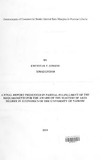Determinants of commercial banks interest rate margins in post-war Liberia

View/
Date
2011Author
Gibson, Ebenizar Z
Type
ThesisLanguage
enMetadata
Show full item recordAbstract
The role of commercial banks is vital to jump start the economy as many citizens are engaged in
commercial activities to meet the needs for their families. Also, macroeconomic phenomenon in
the economy affects the interest rate margin (the spread or margin between lending and deposit
interest rates) remain vitally important barometers of financial performance in depository
institutions. Therefore, it is important to understand this measure and how it is affected by both
internal factors peculiar to a bank and external conditions that bank can hardly influence. Banks
usually borrow short-term funds from depositors and provide long term loans. There is a need to
know the interest rate margins of commercial banks: there is limited or complete absence of
empirical clarity in Liberia.
This study has empirically tested the determinants of commercial bank interest rate margins in
Liberia using bank-specific, industry-specific and macroeconomic data. It is well noted that the
determinants of interest rate margins are unclear in nature in different countries. There have been
numerous studies that discovered that these determinants are either bank-specific, industryspecific
or macroeconomic determined. Annual reports of the Central Bank of Liberia, annual
balance sheets of the commercial banks and income statements were the main sources of data for
the period 2004-2010.
Pooled OLS was conducted making use of cross-section fixed effects since it is consistent with
the data used in this study. The theoretical basic for this study is the Ho and Saunders (1981)
dealership-model which proxied banks as dealers in securities.
This study used the net and narrow interest rate margins (NIM and NAIM) to get good results.
The empirical results indicate that increases in equity, liquidity, overhead costs, bank market
power and changes in exchange rates all lead to an increase in NAIM while intermediation has a
negative correlation with NAIM. All these effects are statistically significant. An increase in
overhead costs increases the NIM while liquidity has a negative association with NIM. More
emphasis is placed on policy implementation compared to formulation in this study since there
are more policies and initiatives to improve efficiency but lack of implementation in the Liberian
banking sector.
Citation
MA ThesisSponsorhip
University of NairobiPublisher
School of Economics, University of Nairobi
